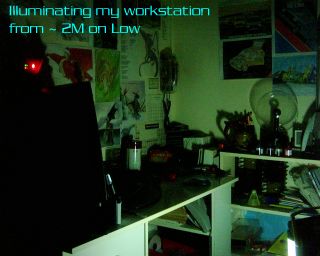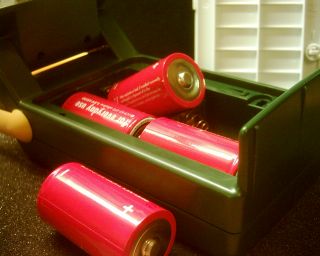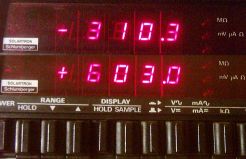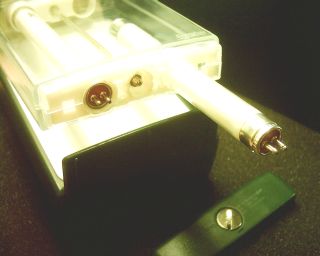ARCHIVED PAGE - PLEASE READ!
This page was written by me a long, long time ago. As such the quality of the writing, photography and/or any conclusions I may have come to simply do not stand up to the levels I consider necessary these days.
I do not believe in deleting things outright though as I feel that these pages form something of a time capsule from an earlier stage in my life, and may still be of some interest to folks who have been coming here for a long time. So instead of deleting this page it has been archived.
PLEASE NOTE THAT THIS PAGE HAS BEEN ARCHIVED, AND SHOULD BE CONSIDERED "FOR INTEREST ONLY" AND NOT BE USED FOR ANY OTHER PURPOSE. LINKS, PRICING ETC ARE LIKELY TO BE OUTDATED AND WILL NOT BE UPDATED.
![]()

Energizer Illumifold Lantern. Rating: 88%

This is another fluorescent lantern. An inexpensive one at that. However, it is a very GOOD fluorescent lantern, despite the price. And that's what matters. It uses two bright 5W fluorescent tubes to produce a large amount of cool white light, running of 4 D size cells.
I will however take this opportunity to appologise for the quality of the photographs on this page. This light's too big to photograph on "macro" mode for my camera, and it really doesn't deal well with closeups in normal mode, hence the fuzzy and grainy look to a lot of them. I've had to actually take the photos from the other side of the room, then enlarge them! I've retaken a couple - but not all!
Product Info:
Manufacturer: Energizer.
Available from: Unknown
Price (Correct at time of writing): US $12.95 (~£7.20).
Size: (folded) 20cm x 7cm x 10cm.
Number of lamps: 2.
Lamp Type: F4T5 Linear Fluorescent tubes.
Current Consumption: (Low) 310.3mA (High) 603mA (On Tesco Everyday Alkaline Batteries).
Lamp Colour: Cool White.
Body finishes available: Dark Green.
Battery type: 4D (LR20) Alkaline. (Not Supplied).
Switch Type: 3 position slide. High, Off, Low.
Water Resistance: Light Splash Resistant only.
Approximate Beam angle: ~180-360°.
Notes: Lantern is covered by a limited lifetime warranty. All measurements taken using a Solartron 7045 Digital Multi meter unless otherwise stated.


Packing:

Full Size Packing pics -
The Energizer Illumifold Lantern (Hereby called the "Lantern" for the purposes of this review), comes in a large sonic welded retail pack in Energizer's usual colours. The front part of the lantern is actually exposed, allowing a potential buyer to see how the folding part actually works. There is also a "clingfilm" type sticker applied to the lens, explaining the differences between the light levels. A close up of this film is shown to the below.

Now, we ALL know how ridiculously hard to get into this type of packaging can be. Energizer at least seem to have made some effort to make it a bit easier though, by the provision of perforations in the back of the packaging to aid in tearing the plastic. I found these to be totally useless though, and after a few seconds, resorted to the "Scissors round the edge" method. This allowed the card and the light to be removed easily, and the most part of the packaging to be retained for future reference. Which for a reviewer IS an issue.
It isn't the hardest of packages to get into, but in the same breath, neither is it the easiest.
There is also a statement of a limited lifetime warranty marked on the package, this is always a good thing to know. And from what I've heard, Energizer do stand by their products and honor that warranty.
The only real complaint I have about this packing, is that the front of the lantern is exposed. If I was buying one of these off the shelf, I'd make sure that the one I was getting wasn't scratched, as I can see that being an issue.
Power Source:
One of the main selling points about this lantern is that it runs for a relatively long time on a set of cells, while still giving out a lot of light. Obviously, to do this, you need a pretty hefty power source. And there's only two types of readily available primary (non-rechargeable) batteries which fit the bill. 4R25 (those big square ones with the spring terminals on top), and D cells. This lantern uses the D cell option. 4 of them. Unfortunately, they are not supplied with the lantern, so you'll need to go out and buy some before you can start playing with....er....testing I mean, this lantern.
Once you get your new D cells, it might not seem totally apparent what to do with them. There's no readily apparent battery door. Well, yes there is actually, here's a hint: Unfold the lantern. See, there is is. That big rectangular white thing you thought was just a reflector. Here's how you change the batteries.
1. Turn off the lantern if it's been in use, and unfold the lens section. Doesn't need to go all the way, just 90° will do nicely.
2. Using either a coin or a large flat bladed screwdriver, turn the locking pins through 90° (so the slot is lined up with the open padlock symbol).
3. Now, this I found was the hardest part. Turn it upside down, and with a bit of luck, the battery door should drop off into your hand. However, if your luck is like mine, it won't. I found that I had to give the back of the casing a pretty sharp tap with my hand before the door would finally drop off, allowing me into the battery housing. Theoretically, you could use a small screwdriver or something to lift the door open, but doing so would risk marking the case.
4. Insert your new D cells in their places, as shown by markings inside the compartment. The connectors are well enough designed that the cells don't "pop" out as they do in some cases if they're not held in place by hand.
5. Place the battery door back on, and lock the little locking pins, turning them so that the slot points to the closed padlock symbol.
6. Dispose of the old cells properly, and check your lantern's now working. If not, check the polarity of the cells you just put in there.

The packaging quotes runtimes of 20 hours with both tubes running, and 40 hours with just the one running. These are impressive figures.
Let's investigate shall we.
Mr. Meter Says...

Low: 310.3mA. (Ignore the negative sign, that's me connecting the leads backwards, makes no difference to the reading, I checked).
High: 603.0mA. These figures are reasonable, the ballast/inverter for the second tube appears to draw *slightly* less current than that for the first one, but not drastically so. So, let's do the math.
Energizer quote their D cells at 18Ah (18'000mAh). So, 18/0.603 = 29.85 hours. So that's theoretically nearly 30 hours on high. Whereas they quote 20. And for low, 18/0.310.3 = 58.01 hours. They quote 40. So these runtimes are certainly realistic. A refreshing change compared to a lot of those we see floating around! Once you take into account the fact that you'll never drain the cells completely, and that at these current levels the effective capacity may be reduced somewhat, probably to about the figures that Energizer quote.
A runtime like this, with output like this, using cheaply and commonly available cells makes this a GREAT power outage light. I haven't had a chance to test it with rechargeables though, as I do not have any rechargeable D cells.
Lamps:

If there's one way in which makers of battery powered fluorescent lanterns often shoot themselves in the foot, it's by using weird proprietary tubes. Which aside from inflating the cost every time you need a new one, means that you're totally out of luck when five years down the road, they stop making them. Yes, I do speak from experience here.
No such problem here though, as the lantern uses two very, very, very standard F4T5 linear fluorescent tubes. These are the same tubes as used by those little 4AA powered lanterns which have been sold in the zillions (in the UK anyway) for £5 forever. The tubes themselves should last a good long time, so long as you don't run the lantern for too long once it starts to dim (as this can cause damage to the tube electrodes, the visible evidence of this being the blackening of the tube ends - though some blackening of the tube ends is normal in T5 tubes due to the lack of electrode shields as seen in the larger T8 tubes), and you don't turn it on and off every ten seconds. As the actual starting is the hardest thing on this (and any) fluorescent tube. This type of tube really was designed for preheat starting, but in this lantern (and nearly all battery powered ones aside from the REALLY expensive ones), it's not heated. It's started "Cold cathode" style, just using a very, very high voltage to strike it. This isn't terribly good for the tube, but does work. And so long as the tube's actually on for 10-20 minutes every time it's started, the reduction in lifetime should be less noticeable.
I do however have a grumble about these tubes. And it basically stems from them being so cheap. It's the colour. Turn them on in a totally dark room, and you'll say "cool white", however, turn them on in a room lit by "normal" light, even daylight, and they look really blue. This seems to be true for nearly every tube of this size I've seen, but I KNOW they are available in colour temperatures other than the 6000°K seen here. I do have ONE 3500°K tube, and it makes it a far more pleasant light to use for reading or just general use.
I'm guessing the reason such a high colour temp tube's been used is for efficiency. As I recall, that phosphor combination is somewhat more efficient than the triphosphor type used on most higher wattage and compact fluorescents.
I have another two of this size/wattage of tubes, but with a twist. They're 352nM blacklight tubes, as seen in those Cheap & Nasty (TM) fluorescent money checkers. The units fell apart many years ago, but I kept hold of the tubes. I found that they work rather well in this lantern, meaning that you can very cheaply make yourself a rather powerful, long running and portable blacklight source. Just replace the tubes with two F4T5BLB tubes.

Though these tubes do have a long lifetime, chances are you'll need to replace them at some point, or you'll want to change them for another type...whatever. Here's how to do it.
1. Turn off the lamp, this is important, as this thing operates at a relatively high voltage (I measured 75V open circuit between two terminals that you could touch when changing the tube) and is quite capable of giving you quite a nasty nip. It did to me anyway).
2. Lift the folding section far enough from the body of the light so that you can get to the large metal screw in the base of the clear section. Unscrew it.
3. Remove the green end cap and...put it somewhere safe. You will need it later.
4. Withdraw the tube(s) in need of replacement from their position within the lens.
5. Insert the new tube so that the pins rest on the little metal prongs you can see in the base.
6. Place the end cover back on, and retighten the screw. DO NOT OVER TIGHTEN it, or you might crack it.
7. Test the lantern, everything should now be good.
Operation:

This is another one of those lights which doesn't require a degree in nuclear physics to operate. You've got one big yellow slide switch to worry about, which has big markings next to it "I O II", obviously denoting the positions for low, off and high. That's it. Well...other than the folding bit anyway. And that's pretty self explanatory. Simply grip the lens part reasonably firmly, and rotate it out from the body of the light to the desired angle. There are tactile detents in the movement, so it stays put at whatever angle you put it at. It will also stay upright at any angle, thanks to the weight of the batteries in the base unit.

Ergonomics:
Hmm, what to say about it ergonomically speaking...it's a box. Quite a heavy box too. Though it's been thought out pretty well. The switch is easy to get to, and requires just the right amount of force to operate, and mercifully isn't prone to shooting from one setting to the other, totally bypassing the central off setting when you're trying to turn it off (Unlike the Osram Mini Combi, which was badly prone to doing that). The carry handle's a nice addition, as it would be a bit of a chore to carry this thing around otherwise thanks to the weight. The folding part is handy as well, at it means that the unit can be wedged or balanced in places that no ordinary lantern could, handy in power failures and emergency situations.
Performance:

You can only expect so much from a $12 lantern, that's true. And you tend to think by now, having seen the rather clever design, the impressive runtime and so on...so it can't perform that well then can it...WRONG.
This light really packs quite a punch for the size it is, especially when you bear in mind how long it can give out that much light for.
Even when set on the low mode, it's easily enough to light an average sized room enough for navigation, and reading reasonably close to it if your eyes are okay. And on high, it's perfect for that role, whether or not you have good night vision. I have already proved as well, that it produces more than enough light for hunting around in the loft for things as well! Hence, would make a good tent/caravan light too.
One thing to remember though, is that fluorescents lamps (or more accurately, the phosphor on them) doesn't perform well when cold. Hence if you're in a particularly cold location (i.e. a tent), the light may start out very dim, taking a minute or two to get up to full brightness. This does not indicate a fault with the unit, and is simply a characteristic of the lamps.
Durability Department:
This is not a $200 Surefire tactical light, it's not made from aircraft grade aluminium, and it's not waterproof to 500 feet below sea level. It's a $12 fluorescent lantern.
That said, it doesn't feel particularly cheap or nasty. And there are just too many screws holding it together for it really to be a piece of cheap trash. It sounds hollow and plasticy if you tap it, but on closer inspection, the plastic is all really rather thick. Just over 1mm thick in the case of the clear lens portion. And the action of the folding part is very positive, with fairly distinct detents holding it where you put it.
The main disadvantage the light has here, is the weight of those batteries. Throw it around the room empty, and it'll survive just fine, but put four D cells in there, and its mass increases considerably. It survived being dropped off the desk, and a slightly higher (4 feet) shelf without any trouble (aside from a REALLY loud, solid sounding bang when it hit the floor), so it's at least reasonably durable. The finish isn't protected in any way, so it will pick up scratches and such like over time, but that'll not really affect the performance in any way. If you try, you can probably break it - but if you treat it as you would any other lantern that you'd hold on to for a camping trip or blackout, it'll be just fine. It's sturdy enough to take the bumps and knocks of every day life.
As for water resistance...well...there isn't any. Quite simply. So keep it out of rain, swimming pools, washing machines and such like. If it does get soaked, DO NOT TURN IT ON, as that would probably kill it, and most likely give you a bit of a zap too, open it up, (rinse out thoroughly with clean water if it's got salt water in), and place them somewhere warm to dry out for a while. So long as it wasn't powered on while wet, it should recover fine.
Overall:
There's one thing that you can't get away from with these lanterns. They're excellent value for money. If you live in an area where there are powercuts on a semi-regular basis, these things would be a godsend. They're small enough to stuff in a cupboard somewhere, but bright enough to actually be useful when needed. As a bonus, they actually run long enough to see most things out too!
I know I just said it as well...but c'mon...at $12, they're a bargain!
Pros:
+Bright!!!
+Uses cheap and easy to find batteries.
+Uses common easy to find tubes.
+Easy to use.
+Durable for what it is.
+Dual output level.
+Excellent battery life.
+Excellent value for money.
+Innovative folding design.
Cons:
-Not waterproof.
-Less than great colour temperature.
Niggles:
>Battery cover can be a PAIN to get off.
>It ain't light - but neither is any 4D powered lantern...
Ratings:
Beam Quality: 9
Build Quality: 8
Battery Life: 10
Durability: 7
Value: 10
Overall: 44 / 50 = 88%
Long Term Testing:
10th Oct 2004: Review Uploaded. Long term test updates will be posted here as they happen.
3rd August 2009: review fixed for the new server. Will be bringing this lantern back into the flat with me shortly, as I don't want to put it into storage. Feel it deserves to get a bit more use than it has of late. My parents keep one handy however (with GE F4T5 /830 tubes in) for power cuts which they suffer from quite frequently, and they swear by it.
5th January 2021: Page moved to Archive Section.
23rd April 2023: Removed dead hyperlinks.
28th April 2023: Revised Statcounter code to allow for HTTPS operation.